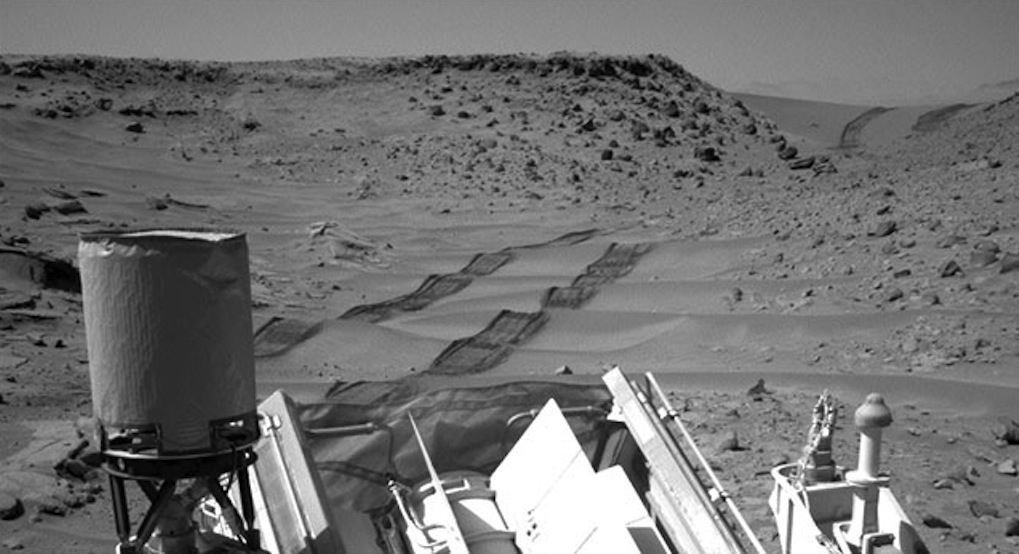
A new video shows NASA's Mars rover Curiosity playing dune buggy, clambering over a drift of sand on its way toward a big Red Planet mountain.
The Curiosity rover video, which is comprised of nine images captured by the robot's rear hazard-avoidance camera, shows the six-wheeled explorer climbing up and over a sand dune on Feb. 6.
"At the start of the drive, the rover's right-front wheel was already at the crest of the 3-foot-tall (1-meter-tall) dune, with the rover still pointed uphill," NASA officials wrote in a description of the video, which was released Tuesday (Feb. 11). "By the last three images in the series, the rover was headed downhill."
Curiosity crossed the dune to find a relatively smooth route to the foothills of Mount Sharp, which rises 3.4 miles (5.5 kilometers) into the Red Planet sky. Mission scientists want the robot to climb up through the mountain's lower reaches, reading a history of Mars' changing environmental conditions as it goes.
The 1-ton Curiosity rover landed in August 2012 to determine if the Red Planet could ever have supported microbial life. It has already answered that question, finding that a spot near its landing site called Yellowknife Bay was indeed habitable billions of years ago.
Curiosity departed the Yellowknife Bay area for Mount Sharp last July and is slated reach the mountain's base around the middle of this year, mission team members have said.
Topping the dune was a big milestone, and the rover notched another one shortly after leaving the feature in its rearview mirror — 5 kilometers (3.1 miles) traveled on the Red Planet surface.
Get the Space.com Newsletter
Breaking space news, the latest updates on rocket launches, skywatching events and more!
"Cue 'Chariots of Fire'! (No slo-mo required.) I just rolled over the 5 km mark on Mars," NASA officials announced today (Feb. 12) via Curiosity's official Twitter account, @MarsCuriosity.
The long haul to Mount Sharp should vault Curiosity past NASA's Spirit rover, which covered 4.8 miles (7.7 km) of Martian ground between 2004 and 2010. But Curiosity will have to keep roving for a long time to catch Spirit's twin, Opportunity, whose odometer reads 24.07 miles (38.73 km) and counting.
Opportunity, which is still alive and well, is the American record-holder for off-planet distance driving. But the overall mark belongs to the Soviet Union's remote-controlled Lunokhod 2 rover, which logged 26 miles (42 km) on the moon in 1973.
Follow Mike Wall on Twitter @michaeldwall and Google+. Follow us @Spacedotcom, Facebook or Google+. Originally published on SPACE.com.
Join our Space Forums to keep talking space on the latest missions, night sky and more! And if you have a news tip, correction or comment, let us know at: community@space.com.

Michael Wall is a Senior Space Writer with Space.com and joined the team in 2010. He primarily covers exoplanets, spaceflight and military space, but has been known to dabble in the space art beat. His book about the search for alien life, "Out There," was published on Nov. 13, 2018. Before becoming a science writer, Michael worked as a herpetologist and wildlife biologist. He has a Ph.D. in evolutionary biology from the University of Sydney, Australia, a bachelor's degree from the University of Arizona, and a graduate certificate in science writing from the University of California, Santa Cruz. To find out what his latest project is, you can follow Michael on Twitter.










